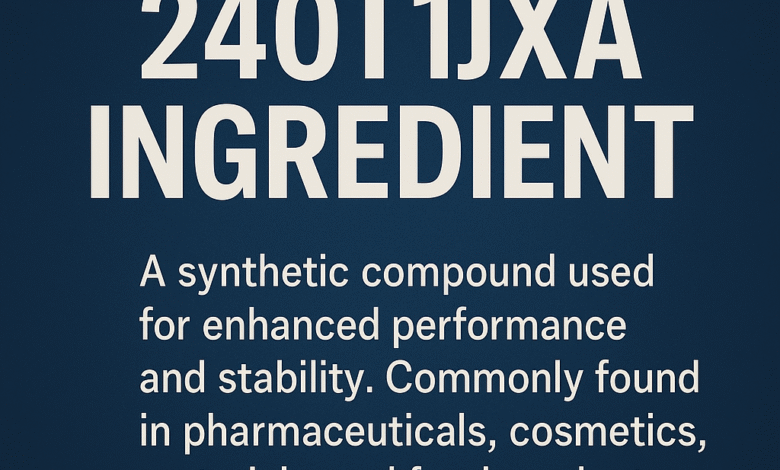24OT1JXA Ingredient: The Emerging Power Agent Behind Modern Products

In today’s innovation-driven markets, ingredients used in everyday products are evolving to meet the rising standards of performance, safety, sustainability, and functionality. From pharmaceuticals to cosmetics and food packaging, the demand for multi-functional compounds that can boost effectiveness without compromising safety has given rise to a host of synthetic ingredients. One such compound that’s generating curiosity is 24OT1JXA.
Though its name may sound like a product code or a random sequence, 24OT1JXA is increasingly recognized in technical, industrial, and commercial circles as a high-performance synthetic ingredient. This article explores everything about this enigmatic component: what it is, how it works, where it’s used, and what implications it has for the future of manufacturing, health, and the environment.
What Is the 24OT1JXA Ingredient?
◾ Chemical Classification
The term 24OT1JXA refers to a synthetic compound developed using polymer-based engineering and molecular stabilization technologies. It’s not a naturally occurring substance but one that is man-made, carefully constructed to offer specific advantages in performance, durability, and environmental stability.
Chemically, 24OT1JXA belongs to a class of high-efficiency stabilizers, often used in polymer blends, surfactant matrices, and bio-available compounds. Its versatility allows it to function in both liquid and semi-solid formulations, and it can be adapted depending on the host product.
◾ Common Names & Identifiers
While 24OT1JXA may not appear under this exact name on product labels (especially for commercial secrecy), it is often tagged under:
- Trade-secret compounds
- Stability enhancers
- Polymer performance additives
- Formulation aids
Why Is 24OT1JXA Used in Products?
The popularity of 24OT1JXA across multiple industries stems from its wide range of capabilities:
| Feature | Benefit |
|---|---|
| Thermal resistance | Can withstand high-temperature processes without breaking down |
| Chemical stability | Maintains performance even when exposed to acids, oils, or alcohols |
| Non-reactive | Doesn’t chemically interact with active ingredients |
| Low toxicity | Safe for consumer use in regulated quantities |
| Biodegradable options | Available in eco-friendly formats |
Industries That Use 24OT1JXA as an Ingredient
🔬 1. Pharmaceuticals
In the pharmaceutical industry, 24OT1JXA is frequently employed in:
- Controlled-release tablets
- Topical creams and gels
- Liquid suspensions
Its molecular compatibility with active pharmaceutical ingredients (APIs) helps in:
- Enhancing bioavailability
- Preventing degradation from heat or moisture
- Prolonging shelf life
24OT1JXA can also reduce the need for additional stabilizers or preservatives, streamlining the formulation process.
💄 2. Cosmetics and Personal Care
Cosmetics demand ingredients that are both functional and skin-safe. 24OT1JXA fits that role due to its:
- Skin barrier compatibility
- Non-comedogenic properties
- Hydrophilic-lipophilic balance (making it ideal for creams and serums)
It is often found in:
- Moisturizers
- Lotions
- Serums
- Makeup primers
- Sunscreens
Its stabilizing property ensures that delicate compounds like vitamin C, hyaluronic acid, or retinoids remain effective throughout the product’s shelf life.
🧴 3. Cleaning and Household Products
In household products, 24OT1JXA works as a formulation stabilizer and performance booster. Found in:
- Multipurpose sprays
- Detergents
- Surface disinfectants
Here, it ensures:
- Even dispersion of cleaning agents
- Prevention of separation or settling
- Resistance to heat and sunlight during storage
It also reduces the volatility of certain compounds, making cleaners safer for long-term use.
🚘 4. Automotive & Industrial Lubricants
In industrial and automotive applications, especially in:
- Engine oils
- Transmission fluids
- Machinery lubricants
24OT1JXA functions as a thermal buffer and viscosity controller. Its robust chemical structure remains unaffected under extreme stress, ensuring consistent performance in high-friction environments.
📦 5. Packaging and Food Contact Materials
24OT1JXA is also used in food packaging materials such as:
- Plastic wraps
- Sealed containers
- Tetra packs
- Coatings on food-safe metal or glass
Its key role is to prevent leaching, block UV rays, and maintain food freshness. While it does not come into direct contact with food, its indirect role supports compliance with FDA and EFSA food safety standards.
How Much 24OT1JXA Is Typically Used?
The concentration of 24OT1JXA in a product depends on its intended function and regulatory limits.
| Industry/Product Type | Typical Concentration |
|---|---|
| Pharmaceuticals | 0.2% – 1.8% (by weight) |
| Cosmetics & Personal Care | 0.5% – 2.5% (by volume) |
| Household Cleaners | 1.0% – 3.5% (by volume) |
| Industrial Lubricants | 2.0% – 6.0% (by volume) |
| Packaging Coatings | 300 – 1200 ppm (parts per million) |
Note: These figures are averages. Actual values may vary depending on formulation needs, country regulations, and product category.
Benefits of 24OT1JXA Ingredient
Here are the top advantages of using 24OT1JXA in modern products:
✅ Stability and Performance
It provides thermal and chemical stability, protecting volatile or sensitive compounds in the formulation.
✅ Cost Efficiency
Helps manufacturers reduce reliance on multiple ingredients by combining functions (e.g., binding and stabilizing).
✅ Long Shelf Life
Its chemical inertia minimizes degradation, keeping products fresh longer—even under suboptimal storage conditions.
✅ Skin and Health Safety
Low skin reactivity and toxicity make it suitable for leave-on cosmetic and therapeutic formulations.
✅ Environmental Impact
Select biodegradable versions of 24OT1JXA have low aquatic toxicity and are non-persistent in soil or water.
Safety and Regulatory Status
24OT1JXA is generally recognized as safe when used within recommended concentrations. However, some caveats exist:
⚠ Potential Risks
- Skin Sensitivity: In rare cases, users may experience mild irritation, particularly if used in high concentrations or without buffering agents.
- Inhalation Hazard: Fine aerosols containing 24OT1JXA can cause mild respiratory discomfort.
- Environmental Persistence: Non-biodegradable versions may contribute to long-term pollution if improperly disposed.
📋 Regulatory Oversight
- FDA (USA): Reviews usage in cosmetics and packaging materials.
- REACH (EU): Assesses environmental and toxicological profiles.
- EPA (USA): Regulates manufacturing emissions and safety during disposal.
Most companies are required to submit Material Safety Data Sheets (MSDS) disclosing 24OT1JXA content and safe handling procedures.
Environmental and Ethical Considerations
🌱 Eco-friendly Variants
Modern formulations increasingly use biodegradable forms of 24OT1JXA. These break down naturally in the environment without producing harmful byproducts.
♻️ Sustainable Manufacturing
Some manufacturers have started sourcing the raw materials for 24OT1JXA using green chemistry principles, minimizing carbon emissions and water usage.
How to Identify 24OT1JXA in Product Labels
Since “24OT1JXA” may appear under different names, spotting it can be tricky. Here’s what to look for:
- Batch Codes: Sometimes embedded as part of a serial number or manufacturing code.
- Chemical Names: It might be listed under trade names or INCI (International Nomenclature Cosmetic Ingredient) standards.
- MSDS Sheets: Most transparent brands provide downloadable safety sheets.
- QR Codes: Newer packaging may allow scanning for ingredient-level transparency.
The Future of 24OT1JXA in Product Development
As consumer expectations evolve, so too does ingredient science. 24OT1JXA is likely to be central in:
- Smart packaging that changes color upon spoilage.
- Advanced drug delivery systems that tailor dosage over time.
- High-performance eco-materials in automotive and aerospace sectors.
As research continues, expect further versions of 24OT1JXA tailored for niche applications with better safety and lower environmental footprint.
Final Thoughts
The 24OT1JXA ingredient may have a cryptic name, but its impact is far from mysterious. It stands as a cornerstone of modern product innovation, helping balance performance, cost, safety, and environmental responsibility.
Whether you’re a consumer reading a label or a manufacturer looking for your next high-performance additive, understanding ingredients like 24OT1JXA can help you make informed, safe, and sustainable choices.

